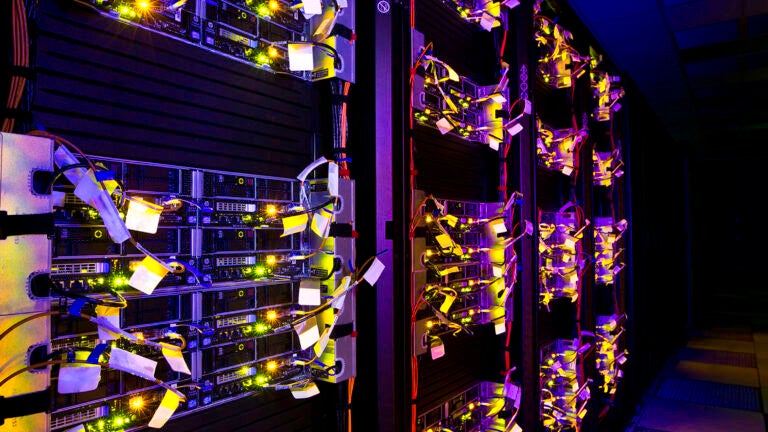
USC’s new supercomputer is ranked fifth in the United States among academic supercomputers. (Photo/John Livzey)
USC’s new supercomputer ranks fifth in the nation
More than three times faster than its predecessor, USC’s new supercomputer has achieved a benchmark of 531.6 teraflops, or 531.6 trillion floating-point calculations per second, making it the nation’s fifth-fastest academic supercomputer, according to TOP500 Supercomputer Sites, which ranks the 500 most powerful computer systems in the world. The new supercomputer is ranked 16th in the world among academic supercomputers and 53rd in the world among all supercomputers.
By comparison, in November 2012, USC’s previous supercomputer achieved a benchmark of 149.1 teraflops and earned the rank of 10th-fastest academic supercomputer in the United States. USC’s new supercomputer is not only significantly faster, but it also takes up one sixth of the space of its predecessor and with its water-cooled doors, is more energy efficient.
Located in the USC Center for High-Performance Computing and Communications (HPCC), the new supercomputer incorporates graphics processing units (GPUs). This technology greatly enhances the speed with which computer systems process information and represents an important development in supercomputing. Nationally, GPU-accelerated supercomputers have enabled new research projects in areas as diverse as bioinformatics, climatology, and molecular and materials modeling.
“HPCC’s world-class supercomputing facility is poised for continuous growth and will allow USC researchers to increase dramatically the pace of their research, leading to new and high-impact scientific discoveries,” said Priya Vashishta, faculty executive director of HPCC.
Vashishta is professor of chemical engineering, materials science and computer science at the USC Viterbi School of Engineering and professor of physics in the Department of Physics and Astronomy at the USC Dornsife College of Letters, Arts and Sciences.
“USC faculty and graduate students on the University Park and Health Sciences campuses increasingly use HPCC’s computing resources, data storage, visualization environments and software to make important scientific and engineering advances in some of the most challenging compute-intensive and data-intensive fields,” he said.
HPCC is an interdisciplinary partnership that bridges USC’s unique strengths in scientific computing, computer science, and high-performance computing and communications by supporting more than 110 research groups in a wide variety of disciplines, including astronomy, civil and environmental engineering, computational biology, earth sciences, epigenetics, health sciences, linguistics, materials science, natural language translation and pharmacology.
For more information about HPCC, visit the new HPCC website.
